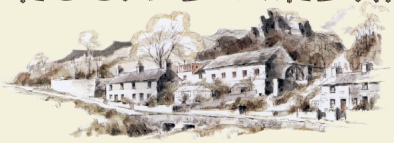
INTERESTING ARTEFACTS
Relics - set three
1, 2, 3 Various decorative bricks, wall copings and path edgings, and on the right (in 2) a cast iron air brick.
4 Ventilation ridge tile, made by Boulton & Co Ltd of Tunstall. Salvaged from Co Durham.
5, 6 Ropes, pulleys and a geared hoist.
7 Cast iron nameplate originally above a curved iron door to a bakery in Bethesda.
8 Display of packaging, old tools, an enamel sign, and an example of the signwriter’s art on a hand painted cab door. Found on Ynys beach, near Harlech. The words read “R Parry & Son, Painter & Decorator, Harlech. Phone 116”
9 The main item here is the hand operated morticer. This proved very useful in making the guard around the waterwheel, and the “Roughwood” display system. To the left and above is a stable window with sliding vent. Draught horses were extensively used on docks, railways and industrial sites. To the right and above is a cast iron nameplate from a machine, and to right and above that is a printed sign for Pant-yr-Ynn reading “Woollen Mill. Quilts, blankets and wool for sale. Visitors Welcome.”
Following the First World War, the mill was fitted
Following the First World War, the mill was fitted
with an oil engine salvaged from a German U-boat, which was used when there was insufficient water to drive the wheel. During the Second Word War the mill made camouflage netting.
10 Lettered slate found loose at Oakeley Quarry.
11 Wheel barrow from Oakeley Quarry.
12 Decorated slates, commonly used for fire surrounds, and a picture of the mill donated by a young visitor and signed.
13 Mangle bearing the name L J Davies, Bala, and a gas cooker - very similar to the one I still use.
14 Two chimney pots, the rear one salt glazed. All chimney pots are larger (and heavier) than they look when on a roof. And many, if not all, have identifying trade names. More unusual is the group of shovels to the right. Salvaged from Dunston Staithes in Gateshead, I believe they were used by trimmers to ensure that coal was pushed well into the corners of ship’s holds. They are remarkable for showing how much they have been worn and mended.
15 “Stretcher” for carrying large stones across steep ground. Used at Pant-yr-Ynn for building the dam and sluices.
During the 1960s and early 70s many Victorian buildings were being demolished to make way for new developments.
This was when I started my work of recording. From time to time I was also able to salvage some items as well, though not as many as I would have liked.
As the following pictures show, these are on display in a rough and ready way along one side of the mill.
The photographs of these relics have been divided into four sets for easy viewing.
This was when I started my work of recording. From time to time I was also able to salvage some items as well, though not as many as I would have liked.
As the following pictures show, these are on display in a rough and ready way along one side of the mill.
The photographs of these relics have been divided into four sets for easy viewing.
Please click on the image on the right to start the detailed slide show of the artefacts